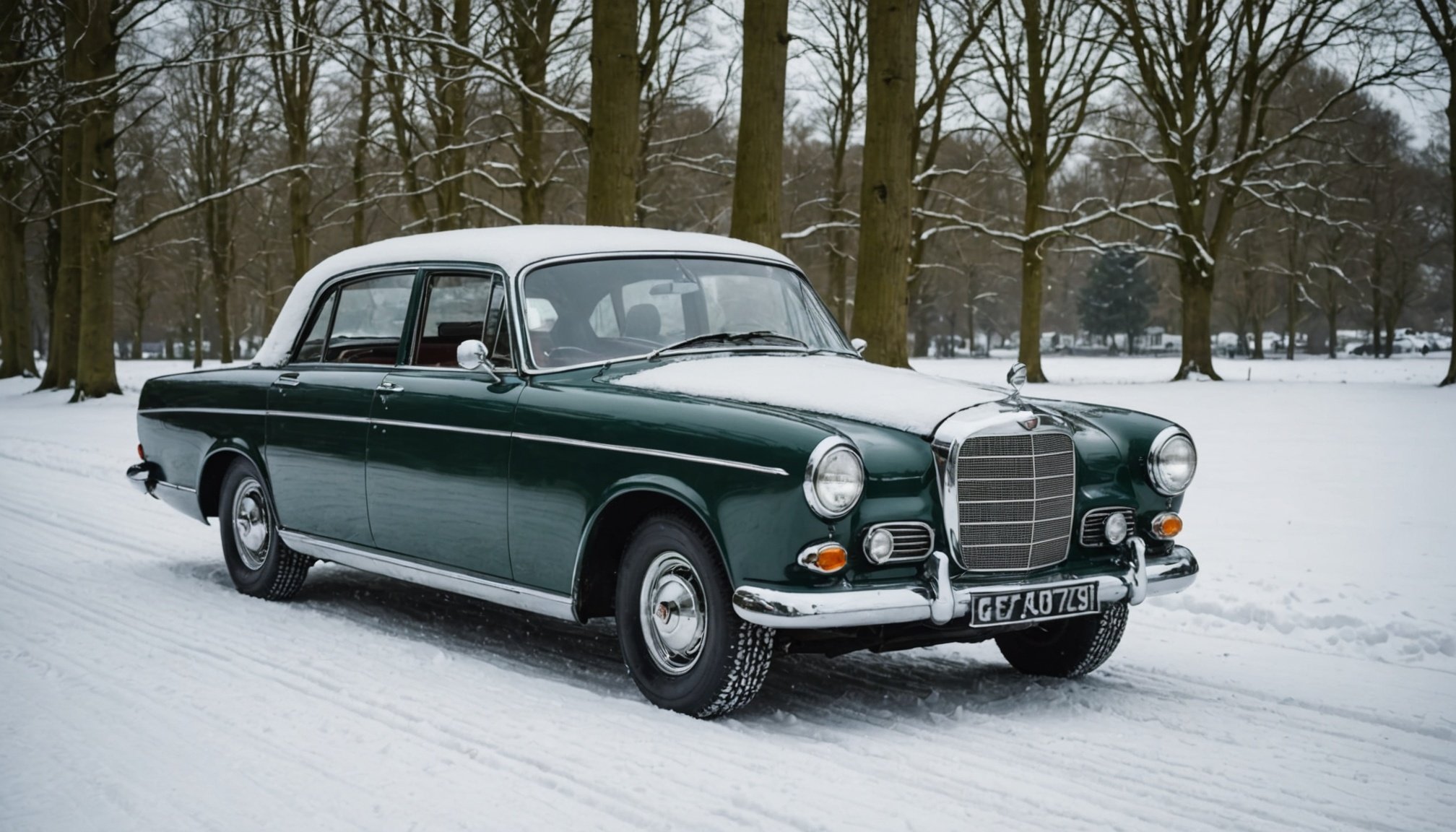Importance of Winter Care for Vintage Cars
Vintage cars require special attention during the colder months due to their unique vulnerabilities. Understanding the impact of cold weather is crucial for vintage car preservation. These classic vehicles often feature materials which can become brittle, and components that might not withstand harsh winter conditions as effectively as modern counterparts.
Winter care isn’t just about safeguarding these treasures for the short term – it offers significant long-term benefits. Proactive winter maintenance prevents deterioration, protecting your investment. Over time, untreated winter damage can lead to significant mechanical failures and cosmetic issues.
Also to see : Key Factors to Consider When Selecting a Windscreen Replacement Service in the UK
Common winter-related issues include rust formation, battery failures, and seized engines due to freezing conditions. These potential problems highlight the need for comprehensive winter strategies to ensure your vintage car remains in prime condition. By focusing on fundamental care measures, like proper storage, regular inspections, and appropriate use of protective coatings, owners can mitigate the threats posed by the colder season.
Ultimately, preserving the integrity and value of these cherished automobiles hinges on effective winter maintenance, enabling enthusiasts to enjoy their vintage cars well beyond the winter months.
Also read : How can technology assist in monitoring your vehicle’s health and performance?
Garage Storage Solutions
Storing vintage cars indoors, particularly in a climate-controlled garage, offers invaluable protection against harsh winter elements. The stable environment reduces exposure to fluctuating temperatures and moisture, both of which can lead to rust and decay. Consequently, maintaining a safe garage space contributes significantly to the longevity and integrity of these treasured automobiles.
To prepare your garage for winter storage, ensure it’s well-insulated and ventilated to prevent dampness and condensation. It’s vital to check for leaks or gaps that could allow cold air or moisture inside. Organize the space efficiently using essential garage organizers, like wall-mounted racks or storage cabinets, to clear the floor and maximise car safety.
Moreover, consider installing a dehumidifier to maintain ideal humidity levels, protecting the car’s components and upholstery. Regularly checking that the garage door seals tight is also key to preventing drafts. By adopting these garage maintenance practices, you ensure your vintage car remains in the best possible condition throughout the colder months, safeguarding it against wear and tear. These efforts in indoor storage will help retain the car’s value and functionality, allowing you to relish its historic beauty come springtime.
Battery Maintenance Strategies
Battery care is vital for maintaining vintage vehicle performance during winter. Cold temperatures can significantly affect battery efficiency, potentially leading to starting issues. Regular battery check-ups and charging will extend its life. Monitoring voltage levels is a practical method to ensure the battery remains in good condition. If the voltage drops below 12.4 volts, consider recharging it promptly.
To prolong battery life, use a quality battery maintainer. These devices keep batteries at optimal charge levels, even during prolonged storage. Removing the battery from the vehicle when it’s not in use can also protect it from deterioration due to extreme temperatures. Before disconnection, ensure you have all the necessary tools and follow the correct removal procedure.
Signs of battery failure often include slow engine turnover, dimming headlights, or frequent need for jump-starts. It’s crucial to regularly inspect battery terminals for corrosion and clean them if needed. Should these symptoms appear repeatedly, seeking replacement becomes imperative. Investing in a reliable battery for your vintage car can prevent inconvenient breakdowns and ensure you enjoy your classic ride, regardless of the season.
Washing and Detailing Techniques
When it comes to car washing in the winter, especially for vintage vehicles, adopting the right techniques is crucial to preserve their delicate finishes. Avoid car washes with harsh brushes; instead, opt for a gentle, hands-on approach with soft microfiber cloths. This prevents scratches on the car’s surface.
Detailing tips for cold weather are essential in maintaining aesthetics and functionality. Before washing, rinse off any salt or debris with a gentle spray to avoid abrasion. Use a high-quality car shampoo that is pH balanced, designed specifically for vintage car finishes.
During the winter months, protecting vintage finishes extends beyond cleanliness. Wax and sealants play a pivotal role. A durable wax ensures a protective layer against moisture and road salt, mitigating potential corrosion. Sealants, on the other hand, offer a longer-lasting shield, enhancing shine and adding an extra barrier.
Incorporating these detailing tips ensures your vintage car not only withstands the winter months but emerges unscathed once spring arrives. Regular attention and careful application of cleaning products safeguard your investment, allowing you to cherish its elegance for years to come.
Tire Upkeep for Safe Driving
Proper tire maintenance is crucial for ensuring vintage car safety during winter. Cold temperatures can significantly impact tire condition and performance. It’s essential to regularly check tire pressure, as it tends to drop in cooler weather, affecting the vehicle’s handling and fuel efficiency. Ensuring tires are properly inflated not only improves safety but also prolongs their lifespan.
Understanding the distinction between winter tires and all-season options is fundamental. Winter tires are specifically designed with tread patterns and rubber compounds that enhance traction on snow and ice, making them more effective than their all-season counterparts in freezing conditions. Therefore, investing in winter tires can markedly enhance driving safety for vintage vehicles during harsh weather.
To maintain your tires’ condition when not in use, consider these storage tips. Store tires in a cool, dry place away from direct sunlight and sources of ozone, such as furnaces and electric motors. If possible, store them vertically and rotate every so often to prevent flat spots from developing.
By committing to thorough tire upkeep practices, vintage car enthusiasts can ensure safer driving experiences and protect their treasured vehicles from winter’s perils.
Applying Protective Coatings
For vintage car preservation during harsh winter, applying protective coatings is essential. These coatings offer a shield against rust, corrosion, and paint damage that cold weather can exacerbate. Solutions like ceramic coatings provide a durable, hydrophobic layer that repels water and reduces the buildup of debris and road salt, which can cause extensive wear over time.
Paint protection begins with selecting the right product. Waxes offer temporary protection, while synthetic sealants and ceramic coatings provide long-term preservation. Always ensure the car is thoroughly cleaned before applying any product, as grime can prohibit adhesion and reduce effectiveness.
When applying these coatings, begin with a completely dry surface. Use a microfiber cloth to evenly apply the substance, making sure to follow manufacturer instructions regarding curing times. Some coatings require specific conditions for optimal bonding, often necessitating a controlled environment.
Regular reapplication of these coatings enhances the proactive winter preservation strategy, ensuring the vintage car emerges from winter unscathed. By prioritising these maintenance steps, vintage car owners can effectively protect their vehicles, preserving both the aesthetic and mechanical integrity throughout the colder months.
Additional Winter Maintenance Tips
Understanding the importance of regular check-ups and inspections can significantly impact vintage car care during winter. Regular evaluations can catch and rectify issues before they escalate, safeguarding against severe cold damage. Ignoring these routine checks can lead to costly repairs and potentially compromise the longevity of your classic vehicle.
To keep the car’s interior safe from moisture, use moisture-absorbing products like silica packs or dehumidifiers placed strategically around the cabin. Always ensure windows and air vents are tightly closed. This prevents the invasion of dampness, which could lead to mould growth and potentially damage the upholstery and electronic components.
For operational efficiency, consider essential winter strategies, such as maintaining the engine through periodic start-ups or short drives. This not only keeps the battery charged but also ensures that fluids circulate regularly, which helps prevent the fuel system and internal components from freezing.
These additional measures enable enthusiasts to enjoy their vintage cars throughout the colder months without worry. Thus, regularly practising these winter maintenance tips can ensure your cherished automobile remains in pristine condition while braving the frigid season.











